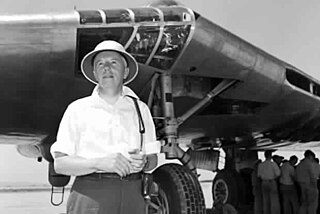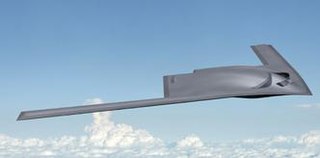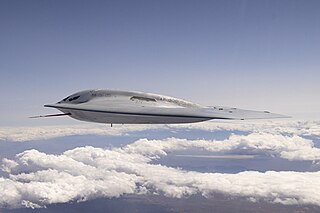Related Research Articles

The Northrop B-2 Spirit, also known as the Stealth Bomber, is an American heavy strategic bomber, featuring low-observable stealth technology designed to penetrate dense anti-aircraft defenses. A subsonic flying wing with a crew of two, the plane was designed by Northrop as the prime contractor, with Boeing, Hughes, and Vought as principal subcontractors, and was produced from 1987 to 2000. The bomber can drop conventional and thermonuclear weapons, such as up to eighty 500-pound class (230 kg) Mk 82 JDAM GPS-guided bombs, or sixteen 2,400-pound (1,100 kg) B83 nuclear bombs. The B-2 is the only acknowledged in-service aircraft that can carry large air-to-surface standoff weapons in a stealth configuration.

The Lockheed F-117 Nighthawk is a retired American single-seat, subsonic twin-engine stealth attack aircraft developed by Lockheed's secretive Skunk Works division and operated by the United States Air Force (USAF). It was the first operational aircraft to be designed with stealth technology.

Northrop Corporation was an American aircraft manufacturer from its formation in 1939 until its 1994 merger with Grumman to form Northrop Grumman. The company is known for its development of the flying wing design, most successfully the B-2 Spirit stealth bomber.
Northrop Grumman Corporation is an American multinational aerospace and defense company. With 95,000 employees and an annual revenue in excess of $30 billion, it is one of the world's largest weapons manufacturers and military technology providers. The firm ranked No. 101 on the 2022 Fortune 500 list of America's largest corporations.

Stealth technology, also termed low observable technology, is a sub-discipline of military tactics and passive and active electronic countermeasures. The term covers a range of methods used to make personnel, aircraft, ships, submarines, missiles, satellites, and ground vehicles less visible to radar, infrared, sonar and other detection methods. It corresponds to military camouflage for these parts of the electromagnetic spectrum.

Stealth aircraft are designed to avoid detection using a variety of technologies that reduce reflection/emission of radar, infrared, visible light, radio frequency (RF) spectrum, and audio, collectively known as stealth technology. The F-117 Nighthawk was the first operational aircraft explicitly designed around stealth technology. Other examples of stealth aircraft include the B-2 Spirit, the B-21 Raider, the F-22 Raptor, the F-35 Lightning II, the Chengdu J-20, and the Sukhoi Su-57.

The Northrop/McDonnell Douglas YF-23 is an American single-seat, twin-engine, stealth fighter technology demonstrator prototype designed for the United States Air Force (USAF). The design team, with Northrop as the prime contractor, was a finalist in the USAF's Advanced Tactical Fighter (ATF) demonstration/validation competition, battling the YF-22 team for full-scale development and production. Two YF-23 prototypes were built.

The General Dynamics/McDonnell Douglas A-12 Avenger II was a proposed American attack aircraft from General Dynamics and McDonnell Douglas. It was to be an all-weather, carrier-based stealth bomber replacement for the Grumman A-6 Intruder in the United States Navy and Marine Corps. Its Avenger II name was taken from the Grumman TBF Avenger of World War II.

The Advanced Tactical Fighter (ATF) was a program undertaken by the United States Air Force to develop a next-generation air superiority fighter to replace the F-15 Eagle in order to counter emerging worldwide threats in the 1980s, including Soviet Sukhoi Su-27 and Mikoyan MiG-29 fighters under development, Beriev A-50 airborne warning and control systems (AWACS), and increasingly sophisticated surface-to-air missile systems. The ATF would make a leap in performance and capability by taking advantage of emerging technologies, including advanced avionics and flight control systems, more powerful propulsion systems, and stealth technology.

Black project is an informal term used to describe a highly classified, top-secret military or defense project that is not publicly acknowledged by government, military personnel, or contractors.

John Knudsen Northrop was an American aircraft industrialist and designer who founded the Northrop Corporation in 1939.

The Lockheed/

Lockheed Have Blue was the code name for Lockheed's proof of concept demonstrator for a stealth fighter. Have Blue was designed by Lockheed's Skunk Works division, and tested at Groom Lake, Nevada. The Have Blue was the first fixed-wing aircraft whose external shape was defined by radar engineering rather than by aerospace engineering. The aircraft's faceted shape was designed to deflect electromagnetic waves in directions other than that of the originating radar emitter, greatly reducing its radar cross-section.

The Northrop Tacit Blue is a technology demonstrator aircraft created to demonstrate that a low-observable stealth surveillance aircraft with a low-probability-of-intercept radar (LPIR) and other sensors could operate close to the forward line of battle with a high degree of survivability.
The Lockheed Senior Prom was a classified black project conducted by the United States Air Force in conjunction with the Lockheed Corporation's Skunk Works for the development and testing of a cruise missile using stealth technology. Based on the company's Have Blue demonstrator, the six Senior Prom vehicles proved successful in testing conducted at Area 51 in the late 1970s; despite this, the aircraft was not selected to enter production, and the program was terminated in the early 1980s.

The Next-Generation Bomber was a program to develop a new medium bomber for the United States Air Force. The NGB was initially projected to enter service around 2018 as a stealthy, subsonic, medium-range, medium payload bomber to supplement and possibly—to a limited degree—replace the U.S. Air Force's aging bomber fleet. The Long Range Strike Bomber (LRS-B) heavy bomber program superseded the NGB program.
Richard C. Scherrer (1919–2018) was an aircraft designer notable for pioneering work on revolutionary aircraft designs with extremely low radar cross sections that led to the Lockheed F-117 Nighthawk and Northrop Grumman B-2 Spirit.

The Long Range Strike Bomber (LRS-B) is a development and acquisition program to develop a long-range strategic bomber for the United States Air Force, intended to be a heavy-payload stealth aircraft that can deliver thermonuclear weapons. Initial capability is planned for the mid-2020s. A request for proposals to develop the aircraft was issued in July 2014. The Air Force plans to procure at least 100 and potentially up to 200 of the LRS-B aircraft for an estimated $550 million each. A development contract was awarded to Northrop Grumman for its B-21 Raider in October 2015. Much about the project is highly classified and little information is available to the public. As of late 2019, it was known that construction of the aircraft had begun, and on December 2, 2022, it was unveiled to the public.
The Northrop Grumman RQ-180 is an American stealth unmanned aerial vehicle (UAV) surveillance aircraft intended for contested airspace. As of 2019, there had been no images or statements released, but evidence points to the existence of the RQ-180 and its use in regular front-line service.

The Northrop Grumman B-21 Raider is an American strategic bomber in development for the United States Air Force (USAF) by Northrop Grumman. Part of the Long Range Strike Bomber (LRS-B) program, it is to be a stealth intercontinental strategic bomber that can deliver conventional and thermonuclear weapons. Named "Raider" in honor of the Doolittle Raiders of World War II, the B-21 is meant to replace the Rockwell B-1 Lancer and Northrop B-2 Spirit by 2040, and possibly the Boeing B-52 Stratofortress after that.
References
- ↑ "Lockheed's Senior Peg: The Forgotten Stealth Bomber".
- ↑ "STEALTH FROM 18-INCH MODEL TO $70 BILLION MUDDLE - The Washington Post". The Washington Post .
- ↑ Pace, Steve (December 2016). The Projects of Skunk Works: 75 Years of Lockheed Martin's Advanced Development Programs. Voyageur Press. ISBN 9780760350324.
- ↑ Sweetman, Bill (1999). Inside the Stealth Bomber. Zenith Imprint. ISBN 9781610606899.
- ↑ Merlin, Peter W. (2011). Area 51. Arcadia. ISBN 9780738576206.